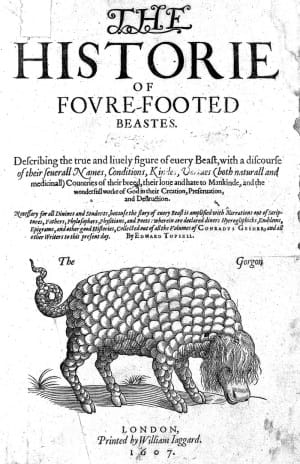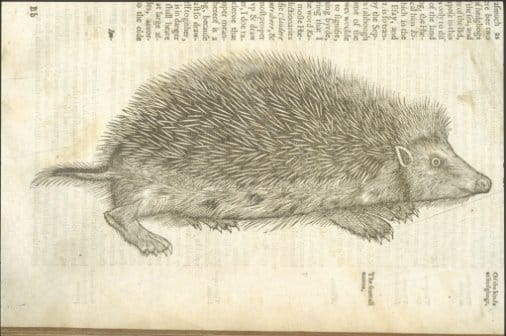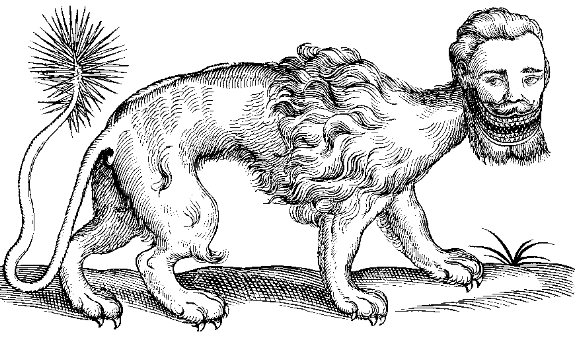The familiar and the fantastic: The historie of foure-footed beastes by Edward Topsell, 1607.
16 Mar 2018
Susan Isaac

Image at right: The historie of foure-footed beastes: Title page with woodcut. From the Wellcome Collection. Free to use with attribution under the Creative Commons Attribution 4.0 International (CC BY 4.0) license.
For example, the hedgehog’s unusual appearance and nocturnal habits led to a number of odd beliefs which Topsell recorded in this book:
The hedgehog’s meat is apple, worms and grapes: when he findeth them upon the earth, he rolleth on them until he hath fylled up all his prickles, and then carrieth them home to his den.
Also included is the legendary Manticore, a creature with the body of a lion and head of man, which was said to bear such a wide grin, you could see its three rows of razor-sharp teeth.
Image: Manticore illustration from "The History of Four-footed Beasts" (1607) by Edward Topsell. From Wikimedia Commons. Public Domain.
Some of the more unusual ideas about familiar animals Topsell shares with us are that weasels mate by their ears and give birth through their mouths, that touching an elephant’s trunk will cure headaches and that a cat is “much delighted to play with her image in a glass”.
Edward Topsell was a Church of England clergyman, born in Kent in 1572. He wrote several books but is most famous for this one. It was followed in 1608 by The history of serpents and the two books were combined in 1658 as The history of four-footed beasts, serpents and insects. His aim was not just to inform and entertain, but to share his belief that the natural world as arranged by God provided an instructive guide which people could study to draw lessons for their own lives. This idea is made clear in the full title he gave his book:
The historie of foure-footed beastes : describing the true and liuely figure of euery beast, with a discourse of their seuerall names, conditions, kindes, vertues (both naturall and medicinall), countries of their breed, their loue and hate to mandkinde, and the wonderfull worke of God in their creation, preseruation, and destruction : necessary for all diuines and students, because the story of euery beast is amplified with narrations out of scriptures, fathers, phylosophers, physitians, and poets : wherein are declared diuers hyerogliphicks, emblems, epigrams, and other good histories.
Topsell wasn’t a naturalist and he borrowed much of his work from others. He admitted that he had copied parts of Conrad Gessner’s popular Historiae animalium. Writing that “I would not have the Reader ... imagine I have ... related all that is ever said of these Beasts, but only [what] is said by many”.
The entry on the Rhinoceros is an example of how Topsell acknowledged his sources and reused material from them in his book. In his description of the Rhinoceros, Topsell tells us that Pliny “do yeeld irrefragable testimony” on the Rhinoceros and that the illustration he uses was made by Gesner “from witnesses in Lisbon”. We know who made the illustrations and why a Rhinoceros was witnessed in Lisbon during this period.
Alfonso de Albuquerque sailed back to Lisbon with a cargo of prestigious gifts ranging from ivory furniture to a live Rhinoceros called Ulysse in 1515. Settled into his new home in the royal menagerie, Ulysse created a big impression. A German printer living in Lisbon sent a detailed letter describing him to Nuremberg. The painter Albrecht Dürer read the letter and sketched a rather exotic-looking Rhinoceros. This sketch became a very popular woodcut, used in several books including Gesner’s.
Image: The historie of foure-footed beastes: "The Rhinoceros". From the Wellcome Collection. Free to use with attribution under the Creative Commons Attribution 4.0 International (CC BY 4.0) license.
The book is contains a vast collection of would-be observational data: real-life merges with the fantastic but it is the illustrations are the real treasure here - they are gorgeous and powerful.
If you are interested in seeing more of The history of four-footed beasts, serpents and insects, a digitised copy can be found at The Internet Archive.
Susan Isaac, Information Services Manager



